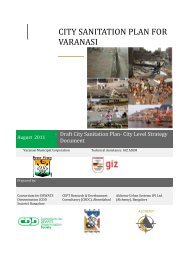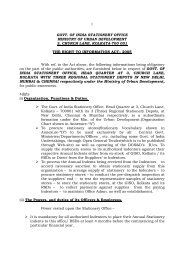CITY SANITATION PLAN - Ministry of Urban Development
CITY SANITATION PLAN - Ministry of Urban Development
CITY SANITATION PLAN - Ministry of Urban Development
Create successful ePaper yourself
Turn your PDF publications into a flip-book with our unique Google optimized e-Paper software.
<strong>CITY</strong> <strong>SANITATION</strong> <strong>PLAN</strong> BAREILLY<br />
Requires constant source <strong>of</strong> water and effluent requires secondary treatment and/or<br />
appropriate discharge<br />
Requires expert design and construction<br />
Reference:<br />
a) Sasse, L. 1998. DEWATS: Decentralized Wastewater Treatment Systems in Developing Countries.<br />
Bremen Overseas Research and <strong>Development</strong> Association, (BORDA), Bremen, Germany<br />
b) Consortium for DEWATS Dissemination (CDD) Society, Bangalore<br />
c) The Vigyan Vijay Foundation, New Delhi<br />
6.3.1a. Options for Removal and Transport <strong>of</strong> Fecal Sludge and Septage<br />
Fecal sludge management must be integral part <strong>of</strong> every sanitation plan, which builds on on-site<br />
sanitation facilities. Sludge management is an indispensable part <strong>of</strong> the maintenance <strong>of</strong> these<br />
facilities. However, in reality sludge management is <strong>of</strong>ten neglected in sanitation planning because<br />
the need for it is less apparent than it is for the provision <strong>of</strong> water supply or toilet facilities. Even<br />
when a sanitation plan foresees a component for sludge management, its implementation is <strong>of</strong>ten<br />
impaired for the same reasons. On-site sanitation systems are <strong>of</strong>ten perceived as cheap in<br />
comparison to sewerage systems, because the investment costs are covered by individuals and not<br />
by the public bodies. However, fecal sludge management is an important cost factor, which cannot<br />
be neglected and which has always to be taken into account when sanitation systems are planned.<br />
Conventional on-site sanitation includes facilities like pit latrines, community/public toilets, flush<br />
toilets connected to septic tanks, etc. In these sanitation systems, feces, urine, and in some cases<br />
grey water is mixed and the sludge produced can be quite diluted. The efforts for sludge collection,<br />
transport and treatment are high, because the sludge is <strong>of</strong> high volume and difficult to handle.<br />
The removal <strong>of</strong> sludge from toilet facilities, and the transport to the site <strong>of</strong> treatment or disposal is<br />
the first important component <strong>of</strong> fecal sludge management. Hygiene with sludge handling is usually<br />
an important issue when manual pit or vault emptying is common. The workers whether<br />
independent or employees <strong>of</strong> private or municipalities, are rarely aware <strong>of</strong> the health risks and may<br />
use no protection during their work.<br />
ADMINISTRATIVE STAFF COLLEGE OF INDIA, HYDERABAD Page 161
















